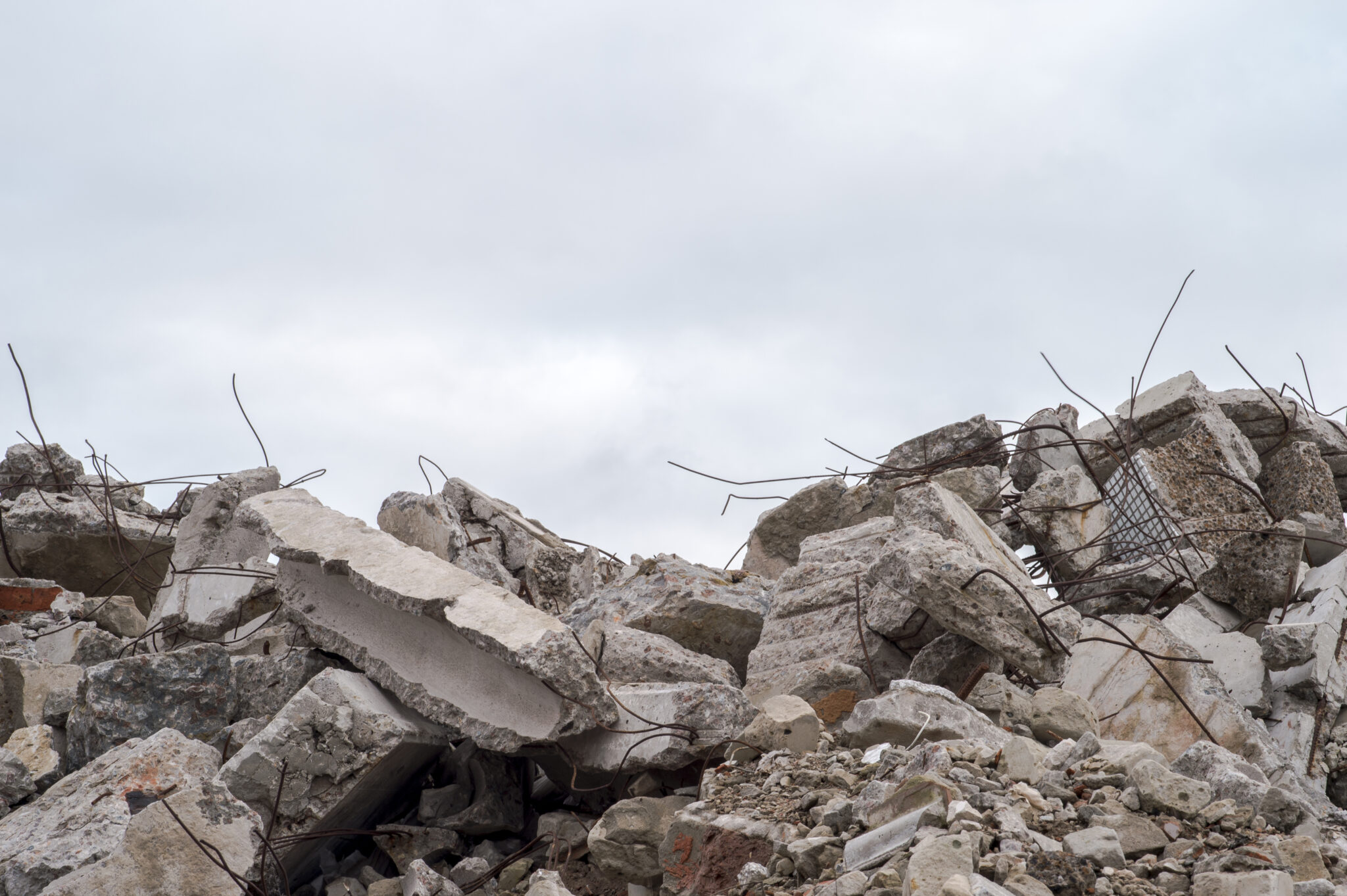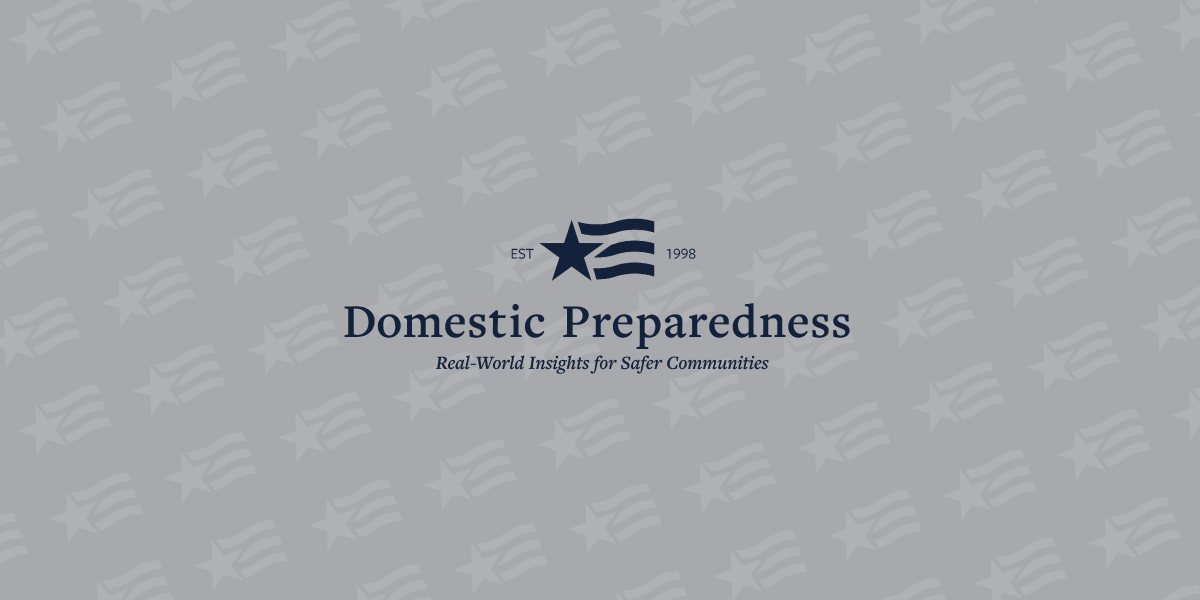Most recently published

Triage Strategies for Hazardous Materials Mass-Casualty Incidents
Duane Caneva
May 3, 2006
What are the best indicators of victim survivability? The RPMs provide a few clues that can be used to START processing. But continuing updates and additional analyses are needed to improve the decision-making process.

Beans, Bullets, and Boxcars: DOD and the Private Sector
Luke Ritter
April 26, 2006
The first question a President asks in times of international crisis is “Where are the carriers?” The first question contingency planners ask is “Where are the cargo ships?” Meanwhile, warfighters are asking “How much fuel & ammunition do we have?”

Preparing to Cope With a Pandemic Flu
Michael Allswede
April 26, 2006
There are several ways, none of them easy-or 100 percent certain-to fight a pandemic that could kill hundreds of thousands of everyday citizens. The Los Alamos project suggests that the first-responder focus should be on vaccinations.

Moussaoui: A Murderer Who Deserves to Die!
Neil C. Livingstone
April 26, 2006
He is a buffoon, a clown, a danger to his own people. Most important of all, though, Zacarias Moussaoui is a mass murderer who knows right from wrong and should be sentenced to death.

It Is Time for a National I.D. Card
Neil C. Livingstone
April 19, 2006
“Immigration Reform” is one of the most important, and most controversial, issues now facing the American people. But no reform bill being considered would work without a requirement for verifiable identification included.

Spotlight Report: Weldon Meets With Fire Service Leaders
John F. Morton
April 12, 2006
Rep. Curt Weldon (R-Pa.), founder of the Congressional Fire Caucus, discusses current programs and future funding prospects with CFSI leaders on the occasion of the annual National Fire and Emergency Services Dinner.

Army Focuses Inland In Latest Realignment
Brent Bankus
March 22, 2006
A major reshuffling of U.S. First Army and U.S. Fifth Army roles and responsibilities will result in more military muscle being made available for homeland security and the increasingly important DSCA (Defense Support of Civilian Authorities) mission.

Rx: A Medical Support Plan for Homeland Defense
Duane Caneva
March 22, 2006
Federal, state, and local disaster-preparedness plans all emphasize the need for adequate medical support. But very little has yet been done to ensure that such support will in fact be available when it is actually needed.

EMS Hazardous Duty: Not for the Meek
Joseph Cahill
March 22, 2006
The members of EMS units are among the first to respond to major disasters in their home communities. They also are on the front lines of danger, particularly in HazMat incidents, and for that reason alone must be among the best prepared & protected.

Jack Beall, Director, National Disaster Medical System (NDMS)
Jack W. Beall
March 22, 2006
Beall discusses DMATs (Disaster Medical Assistance Teams) and other DMS components, the missions of each, and their working relationships with one another.

Evacuation Planning: A Long, Long Way to Go
Joseph Cahill
March 8, 2006
In the years and months after the 11 September attacks, a great deal of work has been done at the federal level both to improve overall domestic preparedness and to standardize the response methods prescribed to deal with major disasters. Homeland Security Presidential Directives (HSPDs) 5 & 8 directed the

The Role of Medical Systems in Homeland Defense
Michael Allswede
March 8, 2006
U.S. medical system is the world’s finest in many respects. However, few if any American hospitals are properly staffed & equipped to deal with this year’s hurricanes, much less one or more new terrorist attacks that could cause thousands of casualties.

Tags of Survival: The Start System
Joseph Cahill
May 3, 2006
The triage goal is to maximize the number of lives saved. But to do so requires some extremely difficult decisions from the EMT on the scene, particularly in mass-casualty incidents when time is limited and information is in short supply.

Triage Strategies for Hazardous Materials Mass-Casualty Incidents
Duane Caneva
May 3, 2006
What are the best indicators of victim survivability? The RPMs provide a few clues that can be used to START processing. But continuing updates and additional analyses are needed to improve the decision-making process.

Beans, Bullets, and Boxcars: DOD and the Private Sector
Luke Ritter
April 26, 2006
The first question a President asks in times of international crisis is “Where are the carriers?” The first question contingency planners ask is “Where are the cargo ships?” Meanwhile, warfighters are asking “How much fuel & ammunition do we have?”

Preparing to Cope With a Pandemic Flu
Michael Allswede
April 26, 2006
There are several ways, none of them easy-or 100 percent certain-to fight a pandemic that could kill hundreds of thousands of everyday citizens. The Los Alamos project suggests that the first-responder focus should be on vaccinations.

Moussaoui: A Murderer Who Deserves to Die!
Neil C. Livingstone
April 26, 2006
He is a buffoon, a clown, a danger to his own people. Most important of all, though, Zacarias Moussaoui is a mass murderer who knows right from wrong and should be sentenced to death.

It Is Time for a National I.D. Card
Neil C. Livingstone
April 19, 2006
“Immigration Reform” is one of the most important, and most controversial, issues now facing the American people. But no reform bill being considered would work without a requirement for verifiable identification included.

Spotlight Report: Weldon Meets With Fire Service Leaders
John F. Morton
April 12, 2006
Rep. Curt Weldon (R-Pa.), founder of the Congressional Fire Caucus, discusses current programs and future funding prospects with CFSI leaders on the occasion of the annual National Fire and Emergency Services Dinner.

Army Focuses Inland In Latest Realignment
Brent Bankus
March 22, 2006
A major reshuffling of U.S. First Army and U.S. Fifth Army roles and responsibilities will result in more military muscle being made available for homeland security and the increasingly important DSCA (Defense Support of Civilian Authorities) mission.

Rx: A Medical Support Plan for Homeland Defense
Duane Caneva
March 22, 2006
Federal, state, and local disaster-preparedness plans all emphasize the need for adequate medical support. But very little has yet been done to ensure that such support will in fact be available when it is actually needed.

EMS Hazardous Duty: Not for the Meek
Joseph Cahill
March 22, 2006
The members of EMS units are among the first to respond to major disasters in their home communities. They also are on the front lines of danger, particularly in HazMat incidents, and for that reason alone must be among the best prepared & protected.

Jack Beall, Director, National Disaster Medical System (NDMS)
Jack W. Beall
March 22, 2006
Beall discusses DMATs (Disaster Medical Assistance Teams) and other DMS components, the missions of each, and their working relationships with one another.

Evacuation Planning: A Long, Long Way to Go
Joseph Cahill
March 8, 2006
In the years and months after the 11 September attacks, a great deal of work has been done at the federal level both to improve overall domestic preparedness and to standardize the response methods prescribed to deal with major disasters. Homeland Security Presidential Directives (HSPDs) 5 & 8 directed the
Dennis Atwood, National Program Manager, MMRS
John F. Morton and Dennis Atwood
March 8, 2006
The MMRS national program manager discusses the program & comments on how local MMRS managers are planning to use community resources to respond to mass-casualty events until external assistance arrives and is operational.
Funding Strategies for EMS Decision Makers
Mary Ungar
February 22, 2006
The huge increase in responsibilities assigned to EMS managers in recent years requires additional funding, and additional time as well. The latter is hard to come by, but DHS and HHS grants will provide significant new funding resources.
Nuclear Resiliency: Command Attention Required
John F. Morton
February 22, 2006
The WWII Manhattan Project mahy serve as the model for a new approach to solve today’s homeland-security problems. A major improvement in senior leadership is needed, and a reallocation of resources, but that would be only the start.
Major General Michael Kostelnik, USAF (Ret)
John F. Morton
February 8, 2006
DomPrep’s John Morton met with Major General Micheal C. Kostelnik, USAF (Ret.), assistant commissioner for Customs and Border Protection’s Air and Marine, CBP’s newly integrated Air and Marine organization.DomPrep has divided the 42 minute interview into eight segments. Listen to Audio Segment OneAir/Marine Integration – The Structure for Administrative and Tactical
How to Build a Protective Wall Along the U.S.-Mexican Border
Neil C. Livingstone
February 8, 2006
Returning illegal immigrants to their own countries will not solve the problem. What is really needed is a strong and constantly monitored high-tech physical barrier that will prevent illegal migrants from entering the United States in the first place.
Cyber Attacks: The Need for Resiliency
Thomas Kellerman
January 25, 2006
Ability of private businesses & public agencies to resume operations following a major disaster used to be taken for granted. That is no longer the case, particularly since hackers & terrorists discovered the damage that could be caused by modern technolo
What Is an Ambulance?
Joseph Cahill
January 25, 2006
It used to be two strong men and a hearse. Modern EMS workers are now much better equipped to provide early lifesaving support both at the scene of an accident or incident and while en route to the nearest hospital or other medical facility.
Terrorism, LE, and the Relevance of Failed States
John F. Morton
January 25, 2006
DPJ’s managing editor discusses a complex new factor in the terrorism/counterterrorism equation: the dangers posed to the Free World by nations out of control, with nothing to lose, and unable to cope with their own political and economic problems.
Major General Donna Barbisch, USA (Ret)
John F. Morton
January 11, 2006
DomPrep’s John Morton met with Major General Donna F. Barbisch, USA (Ret.)” … Barbisch prioritizes planning … when it comes to [providing] medical support in catastrophic-incident responses.”DomPrep has divided the 43 minute interview into four segments. Listen to Audio Segment One“Leveraging existing health system assets for integrated training/planning … [to increase]
Angels on High: CAP Evolves to Meet Homeland-Security Needs
Brent Bankus
January 11, 2006
The Civil Air Patrol, which serves as a valuable and low-cost auxiliary to the U.S. Air Force, continues to change with the times to carry out the new missions assigned to it by its parent service.
General Dennis Reimer, USA (Ret.) Former Army Chief of Staff and Director of MIPT
John F. Morton
December 14, 2005
Details of how emergency responders can benefit from LLIS.gov, the Lessons Learned Information Sharing network, and what they can expect from the Pentagon’s latest review of military support in light of 9/11 and Hurricane Katrina.
The Need for Surge Capacity: Patience Is Not the Solution!
Joseph Cahill
November 30, 2005
The time is NOW to develop detailed plans for the implementation of the mutual-aid agreements without which almost all hospitals in any given area of the country will be forced to rely on stopgap measures–inadequate and too late–to cope with a major disasters
Follow Us
Get Instant Access
Subscribe today to Domestic Preparedness and get real-world insights for safer communities.


